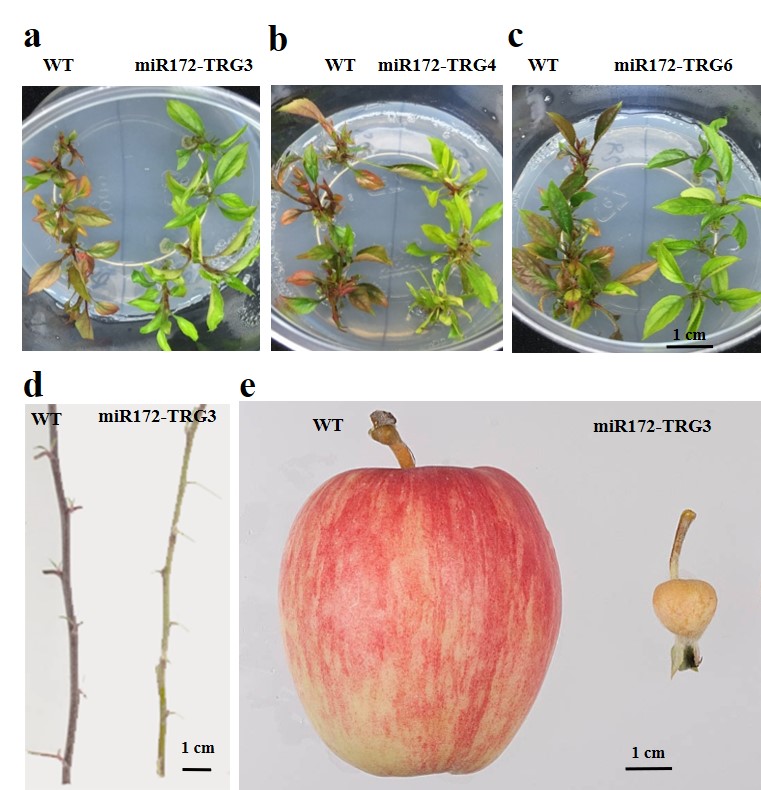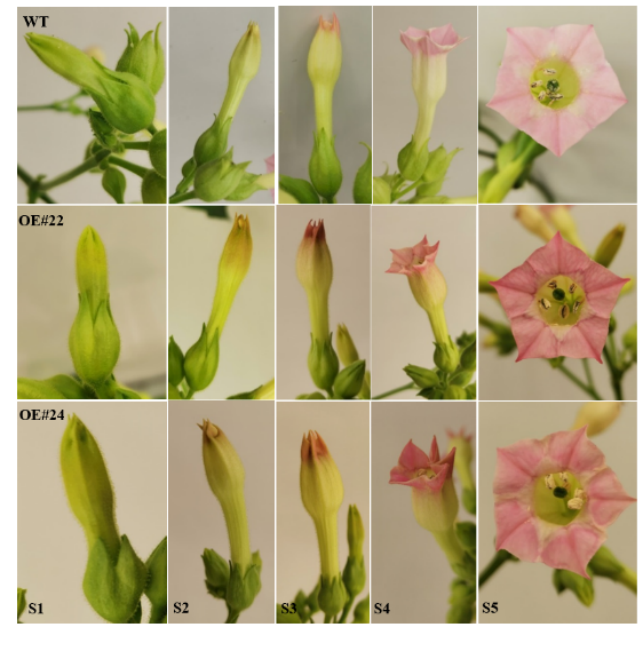The related research results titled "microRNA172 targets APETALA2 to regulate flavonoid biosynthesis in apple ( Malus domestica )" completed by apple germplasm improvement team of Zhengzhou Fruit Research Institute of Chinese Academy of Agricultural Sciences and the New Zealand Institute for Plant & Food Research Limited (PFR) were published online in Journal of Horticulture Research,recently. The study confirms that miR172 negatively regulates anthocyanin synthesis.
Anthocyanins are the most important plant visible pigments besides chlorophyll, giving the red colors to fruits and also benefiting the human body by defending against various oxidants. MicroRNA172 ( miR172 ) plays a role in regulating a diverse range of plant developmental processes, including flowering, fruit development and nodulation. However, its role in regulating flavonoid biosynthesis is unclear. In this study, the transgenic apple plants over-expressing miR172 showed a reduction in red coloration and anthocyanin accumulation in various tissue types (Fig.1). In Arabidopsis , over-expression of miR172 reduced flavonoid (including anthocyanins and flavonols) concentration and RNA transcript abundance of flavonoid genes in plantlets cultured on medium containing 7% sucrose. The anthocyanin content and RNA abundance of anthocyanin genes could be partially restored by using a synonymous mutant of MdAP2_1a , which had lost the miR172 target sequences at mRNA level, but not restored by using a WT MdAP2_1a . These results indicate that miR172 inhibits flavonoid biosynthesis through suppressing the expression of an AP2 transcription factor.
Further research demonstrated that AP2 is an activator of anthocyanin biosynthesis. The positive role of MdAP2_1a in regulating anthocyanin biosynthesis was supported by the enhanced petal anthocyanin accumulation in transgenic tobacco plants overexpressing MdAP2_1a (Fig. 2). MdAP2_1a could bind directly to the promoter and protein sequences of MdMYB10 in yeast and tobacco, and enhance MdMYB10 promotor activity. These results confirm that miR172 inhibits flavonoid biosynthesis through suppressing the expression of an AP2 transcription factor that positively regulates MdMYB10.
The results provide a valuable reference for the application of miRNAs in apple horticultural trait improvement. This achievement is also another important progress made by Zhengzhou Fruit Research Institute in Apple's collaborative innovation research and talent introduction. The first author of the paper is graduated Ph. D. Tiyu Ding from the Zhengzhou Fruit Research Institute, and the corresponding authors are Prof. Jialong Yao from PFR and Prof. Zhenli Yan from Zhengzhou Fruit Research Institute. The research was supported by the National Key Technology Research and Development Program of China (2018YFD1000100); the Agricultural Science and Technology Innovation Program of China (CAAS-ASTIP-2016-RIP-02); and the New Zealand Ministry of Business, Innovation and Employment.
More details are available at the link below: https://doi.org/10.1093/hr/uhab007.

Fig. 1. Over-expression of miR172 in apple reduced anthocyanin accumulation in leaves grown on tissue culture medium containing 7% sucrose (a, b, c), in stem bark (d) and fruit skin (e)

Fig.2. Over-expression of MdAP2 enhanced anthocyanin accumulation in the petals of transgenic tobacco plants compared to WT plants
Ding Tiyu, 1121326300@qq.com
Yan Zhenli,yanzhenli@caas.cn
